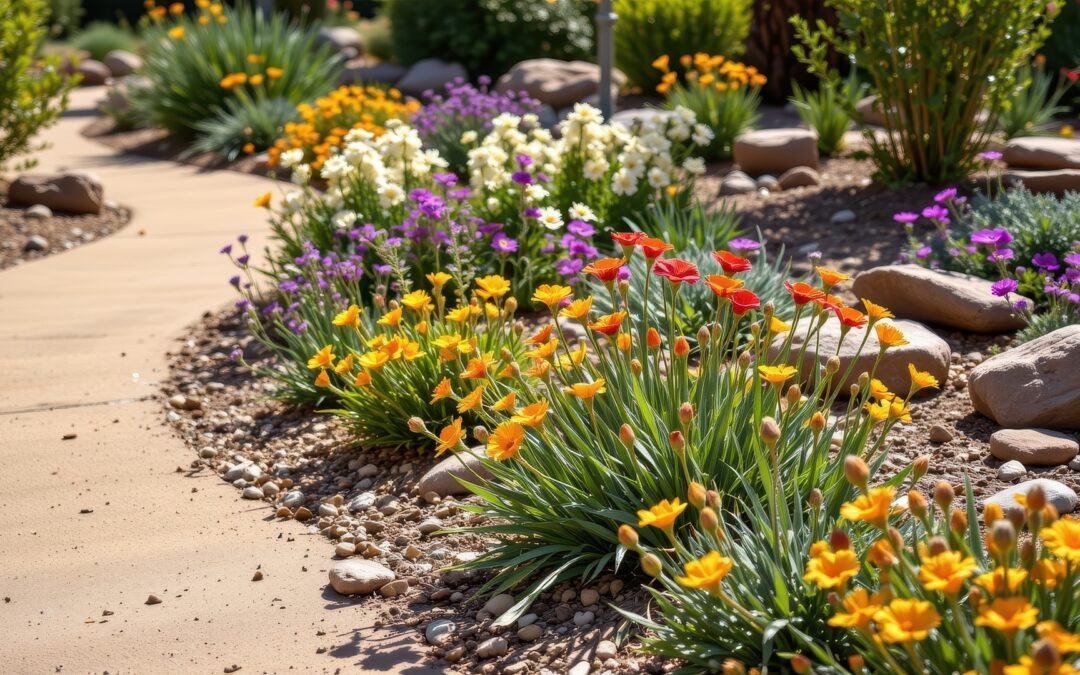Late summer in Colorado Springs can be challenging for any yard. The days are still hot, rainfall can be scarce, and the high-altitude sun can be unforgiving. By September, many landscapes start looking worn out, but with a drought-resistant approach, your outdoor space can stay vibrant while conserving water.
This is where xeriscaping, mulch, and rock features come together to create a yard that not only survives but thrives through the end of summer.
Why Drought-Resistant Landscaping Works in Late Summer
By September, Colorado Springs often experiences warm, dry days paired with cool nights. These conditions put stress on traditional lawns and thirsty plants, making water conservation more important than ever. Drought-resistant landscaping reduces irrigation needs, minimizes plant stress, and still offers beauty and variety.
The key is designing a landscape that works with our climate, not against it. Xeriscaping principles, combined with mulch and rock accents, give you a low-maintenance space that looks intentional and inviting.
Xeriscaping Basics for September Success
Xeriscaping isn’t just about replacing turf with gravel—it’s about thoughtful design using plants and features that thrive with minimal water. In late summer, the right plant mix keeps color and texture in your yard even as other landscapes fade.
Choose Plants That Peak Late
Select drought-tolerant perennials and shrubs that continue to bloom or hold attractive foliage into September. Options for Colorado Springs include:
-
Russian sage – Purple blooms and silver foliage stand up to heat.
-
Blanket flower – Long-blooming and colorful well into fall.
-
Rabbitbrush – Bright yellow blooms in late summer.
-
Autumn Joy sedum – Turns rosy in September and needs little water.
These plants not only conserve water but also keep your yard visually appealing in the final stretch of summer.
Plan for Shade and Shelter
Even drought-resistant plants can benefit from strategic shade. Position taller plants or decorative structures to protect more delicate species from the harsh afternoon sun. This approach reduces water stress and helps plants maintain their shape and color.
Mulch: The Moisture Saver
Mulch is one of the most effective and affordable tools for conserving water, especially as September temperatures can still spike in Colorado Springs.
Why Mulch Matters Now
-
Retains soil moisture – Reduces evaporation so plants can go longer between waterings.
-
Regulates temperature – Keeps roots cooler during hot afternoons and warmer during cool nights.
-
Suppresses weeds – Cuts down on competition for water.
A 2–3 inch layer of organic mulch, such as shredded bark or wood chips, is ideal for most plant beds. It breaks down over time, improving soil quality—another bonus for drought-resistant landscaping.
Where to Use Mulch
-
Around the base of perennials and shrubs to protect root zones.
-
In vegetable or herb gardens to stretch the growing season.
-
Along pathways to keep dust down and add a finished look.
By September, a quick top-up of mulch can freshen your yard visually while continuing to protect your plants through the changing season.
Rock Features: Beauty Without the Water Demand
Rocks are more than just decorative—they’re a functional part of a drought-resistant yard. Used thoughtfully, rock features can define spaces, control erosion, and add interest without increasing water needs.
Benefits of Rock in Late Summer
-
Low maintenance – Rocks don’t require watering, mowing, or trimming.
-
Heat moderation – While some rocks reflect heat, strategically placed stones can shade soil or plants, reducing water stress.
-
Design flexibility – Rocks fit modern, rustic, or naturalistic styles and can be used in everything from pathways to focal points.
Incorporating Rocks into Your Yard
-
Dry riverbeds – Create visual movement and aid in stormwater control during sudden rain.
-
Rock gardens – Combine drought-tolerant plants like sedum and hens-and-chicks with decorative stones.
-
Borders and edging – Frame planting beds with local stone for a polished, cohesive look.
Using native stone blends your landscape into the Colorado Springs environment and can even reduce transportation costs and environmental impact.
Water-Wise Irrigation Tips for September
Even with xeriscaping, mulch, and rock, your plants still need water—just less of it. As days shorten and nights cool, you can adjust your watering schedule.
Irrigation Adjustments
-
Deep, infrequent watering – Encourages roots to grow deeper, making plants more resilient.
-
Morning watering – Reduces evaporation and gives plants time to dry before evening.
-
Use drip irrigation – Directs water exactly where it’s needed, minimizing waste.
By mid-to-late September, many plants will naturally reduce their water needs, so staying mindful of weather patterns can help prevent overwatering.
Designing for Year-Round Appeal
A drought-resistant yard doesn’t have to be all about summer survival—it can be beautiful in every season.
-
Evergreens and ornamental grasses provide structure and color through fall and winter.
-
Seasonal accents like decorative pots, benches, or garden art keep the yard inviting when plants are dormant.
-
Layering plants of varying heights and textures creates visual depth, making the space interesting even during dry spells.
These design touches ensure that your xeriscaped yard continues to look cared for long after the peak growing season.
Maintenance That Pays Off
The best part about drought-resistant landscaping is that it requires less upkeep, but a few end-of-summer tasks will keep your yard in top shape:
-
Remove spent blooms and tidy up plant beds to maintain a fresh look.
-
Inspect mulch and rock areas for weed growth and address any problem spots.
-
Check irrigation systems for leaks or clogs before winter.
Investing an hour or two in September can save time and resources when next spring arrives.
Why This Matters for Colorado Springs
Water conservation is more than just a summer concern in our area—it’s a year-round responsibility. Drought-resistant landscaping not only saves water but also aligns with our community’s commitment to sustainable outdoor living. By choosing plants and features that work with our climate, you’re helping preserve local resources and supporting a healthier environment.
Conclusion: Keep Your Landscape Thriving Through September and Beyond
With xeriscaping, mulch, and rock features, your yard can remain both beautiful and water-efficient well into September. By selecting plants that thrive in our climate, protecting soil moisture with mulch, and adding low-maintenance rock elements, you create a space that stands up to heat while still welcoming you outdoors.
Now is the perfect time to evaluate your landscaping and make changes that will benefit your yard through late summer and for years to come. If you’re ready to embrace a drought-resistant design tailored to Colorado Springs, our team can help you plan and install a landscape that works with our environment—and looks great doing it.






